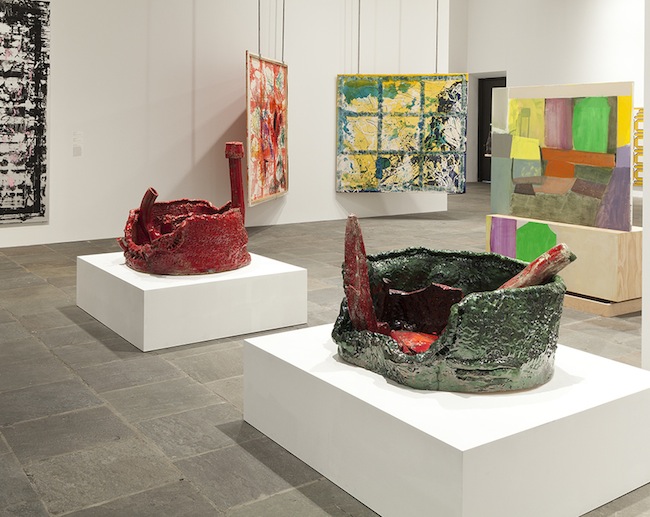If you are going to an art event, whether ceramics related or not, and want to seem to be “in the know,” CFile suggests that you read Sarah Archer’s perceptive review in the always-surprising HyperAllergic on ceramics in the current Whitney Biennial.
Everyone is talking about this and for good reasons, it avoids the clay-world whining (in fact it does some gentle spanking in that regard), it examines the Whitney’s choice with an open but critical eye, puts the emerging role of ceramics in art- perhaps even its new prominence- in context.
“I came away encouraged that this year’s biennial, particularly the fourth-floor galleries organized by artist Michelle Grabner, where Ruby’s sculptures are featured, appears to lay out the welcome mat for every material under the sun. Grabner described her curatorial approach to me as that of building a curriculum: every tradition and technique gets a voice. How will you express your ideas, young artist? What comes across powerfully is both a diversity of materials and an openness about what a given material, and craftsmanship itself, means in the life of an artist. Glenn Adamson, director of the Museum of Arts and Design, characterized Grabner’s section as ‘an exuberant representation of contemporary artists’ engagement with materiality, one of those materials being clay,’ adding that ‘one important achievement of her selection is that every material seems equally valid.’”
What Archer describes touchingly is the irritation that every ceramophile feels when visiting a major art show and encountering a ceramic work that is, in one’s informed (or over-informed) opinion, as not being up to snuff:
“But for a true devotee of studio ceramics, the disappointment of encountering a lackluster vessel in a major contemporary art exhibition can feel a bit like watching one’s hometown starlet turn up at the Academy Awards wearing an unflattering gown.”
She is laying the ground for her defense of Ruby Sterling, one of the most disliked non-ceramists in the ceramics world. It is a club I once belonged to, but no more. She puts the negative reaction down to a fear of “sloppy” craft. But we should remember that the same charge was leveled against Voulkos when he first began his attack on the vessel. We soon discovered that his craft was anything but sloppy, the argument was actually against his style.
Archer argues convincingly:
“Ruby’s ‘sloppiness’ is not arbitrary at all: his deep, dark glazing and almost comically ill-formed vessels can be read as a reflection of a hands-on experience with clay that many of us have had, either at summer camp or in elementary school. This facet of clay’s identity — that of a material ideally suited to childhood sculptural experiments — is just one of many that ceramic objects signify. While John Mason demonstrates irrefutable technical mastery, his is the very connoisseurship model that I suspect Ruby’s aiming to disrupt. Clay’s role in art education and hobbyism resonates with a wide swath of the general public, and Ruby is evidently striking a nerve by making high-profile work that embodies the look and feel of ‘bad pots.'”
I thought she was leading up to another point, the work of Shio Kusaka. She is mum on the subject. The pieces selected for the show were ordinary or at least that was their impact in the show. They are not sloppy but everyday within the studio pottery realm and not biennial-worthy. Offhand I can think of fifty potters more deserving.
When one reads her resume and finds her group of power galleries the selection becomes clearer. Kusaka was not plucked from Potteryville but Blum and Poe. That said, I am not writing the potter off yet, she did leave behind some intrigue for future years.
Grabner’s selection of this work and the type of presentation (when in doubt cluster for safety) comes from someone who seems to admire the activity but not understand the classical pot.
One other aspect of ceramics is missing from the review and that is ceramics as subject, not materiel. Ricky Wallow’s bronze sculptures are drawn from his love of British studio pottery and his Reversed Pitcher 1 was the most radical vessel art on the Biennial in formal terms.
Sarah Archer, according to her profile, is a writer, curator, and all-purpose decorative arts nerd based in Philadelphia. Her articles and reviews have appeared in the Journal of Modern Craft, American Craft Magazine, Artnet, Ceramics: Art and Perception, Hand/Eye, Modern Magazine, Studio Potter, and the Huffington Post.
Garth Clark is the Chief Editor of CFile.
Above image: Ruby Sterling, Pair of Ashtrays, ceramic, on the Whitney Biennial, 2014
Any thoughts about this post? Share yours in the comment box below.

Group of works, two totems and a relief sculpture in stoneware by the octogenarian, John Mason. In her review Sarah Archer amusingly casts Sterling and Mason as “The Odd Couples'” of sculpture with Mason as a neat-freak and Sterling glorying in mess.


Pottery by Los Angles based Shio Kusaka.


Ricky Swallow, also from Los Angeles, Reversed Pitcher 1, 2013. Patinated bronze. Photograph by Fredrik Nilsen.
Read the full article at HyperAllergic

Thank you Garth! I was also stunned at the messy / poor craftsmanship discussion. We have definitely been down this path before as you note with Voulkos and others. It is troubling that many in the art world seems to be plowing the same fields in art and not acknowledging the others who first broke the ground. It continues to be notable that John Mason gets little mention, yet he is among those first down the expressionist ceramics road. As a “mature artist” I find this especially unsettling…
I probably should not get started at the selection of Shio Kusaka.
Kudos to Archer for taking this all on. It is an important conversation to have and it is great to have arrange of voices writing about ceramics. Am struck by the notion any press is good press…